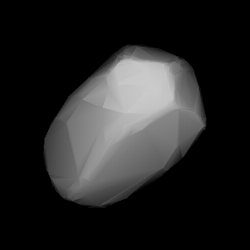|
1767 Lampland
1767 Lampland, provisional designation 1962 RJ, is an Eoan asteroid from the outer regions of the asteroid belt, approximately 15 kilometers in diameter. It was discovered on 7 September 1962, by astronomers of the Indiana Asteroid Program at Goethe Link Observatory in Indiana, United States.[6] The asteroid was named after American astronomer Carl Lampland.[2] Orbit and classificationLampland a member the Eos family (606), the largest asteroid family in the outer main belt consisting of nearly 10,000 asteroids.[3][7]: 23 It orbits the Sun at a distance of 2.7–3.3 AU once every 5 years and 3 months (1,915 days). Its orbit has an eccentricity of 0.10 and an inclination of 10° with respect to the ecliptic.[1] The asteroid was first identified as 1941 SP at Uccle Observatory in September 1941. The body's observation arc begins with a precovery at Palomar Observatory in August 1951, more than 11 years prior to its official discovery observation at Goethe Link.[6] Physical characteristicsIn the Tholen classification, its spectral type is ambiguous, closest to the X-type asteroid and with some resemblance to the C-type asteroids,[1] while the overall spectral type of the Eos family is that of a K-type.[7]: 23 Rotation periodAs of 2017, no rotational lightcurve of Lampland has been obtained from photometric observations. The asteroid's rotation period, poles and shape remain unknown.[8] Diameter and albedoAccording to the survey carried out by the NEOWISE mission of NASA's Wide-field Infrared Survey Explorer, Lampland measures 15.448 kilometers in diameter and its surface has an albedo of 0.116.[4][5] NamingThis minor planet was named after American astronomer Carl Lampland (1873–1951), a graduate of Indiana University, best known for his radiometric measurements of planetary temperatures.[2] Lampland is also honored by a lunar and by a Martian crater. The name was proposed by Frank K. Edmondson, who initiated the Indiana Asteroid Program.[2] The official naming citation was published by the Minor Planet Center on 20 February 1971 (M.P.C. 3144).[9] References
External links
|
||||||||||||||||||||||||||||||||||||||||||||||||||||||||||||
Portal di Ensiklopedia Dunia
